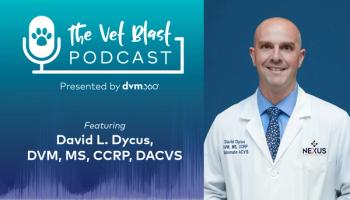
Insulinoma in a senior pit bull: Medical oncology perspective
Dr. Emily Manor provides the medical oncology perspective on this challenging veterinary oncology case.
Dr. Emily ManorSurgery is considered the most effective treatment for canine insulinoma, as multiple studies have shown inferior survival times for patients treated with medical management alone.1-3 However, medical therapy can be considered when surgery is either declined or not advisable because of the extent of metastatic disease. Medical management is also used preoperatively, as an adjunct to surgery when resection is incomplete, and in the case of recurrent disease.
Dietary modifications including avoidance of simple sugars and dividing meals into multiple small feedings (every four to six hours) can help to maintain glucose homeostasis and decrease the stimulus for insulin release. Excitement and strenuous exercise should be avoided to reduce muscle uptake of glucose, which contributes to hypoglycemia.4
Prednisone is commonly regarded as the mainstay of medical management for insulinoma. It is used for its insulin-antagonizing and gluconeogenic effects and is often combined with dietary and environmental modifications for long-term use. Dosing is started at about 0.5 mg/kg/day; this is often divided into two doses. The dose can be increased if control is not satisfactory.4,5 Prednisone therapy is often initiated before surgery to stabilize a patient as much as possible before anesthesia. If normoglycemia is achieved after surgery, prednisone can be gradually tapered and then discontinued.
Octreotide, a somatostatin analogue, has also been used in the medical management of insulinoma. Octreotide works by inhibiting synthesis and secretion of insulin by the pancreatic beta cells. This medication can be cost prohibitive and may be a challenge to administer, requiring every-eight-hour subcutaneous injections. Dosing guidelines vary; 2 to 4 µg/kg subcutaneously every eight to 12 hours, and 10 to 50 µg subcutaneously every eight to 12 hours have been reported.1,4 Efficacy is somewhat unknown, but one study of 12 dogs reported that plasma insulin concentrations decreased and glucose concentrations increased after administration of octreotide.6 Side effects appear to be rare.4
Diazoxide is a benzothiadiazine that blocks insulin release. It is given orally every 12 hours at a starting dose of 5 mg/kg. The dose can be increased up to 30 mg/kg if needed. Diazoxide can also be cost-prohibitive and side effects include gastrointestinal upset.4,5 A 70% response rate has been reported.7
Lastly, streptozocin, an alkylating agent, is the chemotherapy drug used most frequently for canine insulinoma. The structure of streptozocin is similar enough to glucose that it is taken up by GLUT2 transporters, which are in high concentration on pancreatic beta cells.8 Reports of streptozocin's efficacy are limited; one study showed no difference in normoglycemia in dogs treated with streptozocin compared with a control population.9 Another study prospectively evaluated streptozocin in dogs with recurrent, metastatic or residual local insulinoma; a progression-free survival of 6.5 months was reported.8 Use of streptozocin is limited by its high toxicity profile. It is nephrotoxic and must be administered with intensive saline diuresis. It is also emetogenic, can cause transient worsening of hypoglycemia and causes diabetes mellitus in up to 40% of patients.1,4,8,9
The prognosis for canine insulinoma depends on the stage (presence and extent of metastasis) and whether or not surgery is pursued.1-3 A recent retrospective study of 28 dogs reported a median survival time of about six months for patients treated with medical management alone, about two years for dogs treated with surgery alone, and about 3.5 years for dogs treated with surgery followed by medical management at relapse of clinical signs.3
References
1. Goutal CM, Brugmann BL, Ryan KA. Insulinoma in dogs: a review. J Am Anim Hosp Assoc 2012;48:151-163.
2. Tobin RL, Nelson RW, Lucroy MD, et al. Outcome of surgical versus medical treatment of dogs with beta call neoplasia: 39 cases (1990-1997). J Am Vet Med Assoc 1999;215:226-230.
3. Polton GA, White RN, Brearley MJ, et al. Improved survival in a retrospective cohort of 28 dogs with insulinoma. J Small Anim Pract 2007;48:151-156.
4. Withrow SJ, Vail DM, Page RL. Tumors of the endocrine system. In: Withrow and MacEwan's small animal clinical oncology. 5th ed. St. Louis: Elsevier, 2013.
5. Feldman EC, Nelson RW. Beta cell neoplasia: insulinoma. Canine and feline endocrinology and reproduction. 3rd ed. Philadelphia: WB Saunders Company, 2003.
6. Robben JH, van den Brom WE, Mol JA, et al. Effect of octreotide on plasma concentrations of glucose, insulin, glucagon, growth hormone, and cortisol in healthy dogs and dogs with insulinoma. Res Vet Sci 2006;80:25-32.
7. Leifer CE, Peterson ME, Matus RE. Insulin-secreting tumor: diagnosis and medical and surgical management in 55 dogs. J Am Vet Med Assoc 1986;188:60-64.
8. Northrup NC, Rassnick KM, Geiger TL, et al. Prospective evaluation of biweekly streptozotocin in 19 dogs with insulinoma. J Vet Intern Med 2013;27:483-490.
9. Moore AS, Nelson RW, Henry CJ, et al. Streptozocin for treatment of pancreatic islet cell tumors in dogs: 17 cases (1989-1999). J Am Vet Med Assoc 2002;221:811-818.
Newsletter
From exam room tips to practice management insights, get trusted veterinary news delivered straight to your inbox—subscribe to dvm360.




